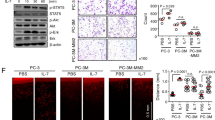Abstract
Interferons (IFNs) can exert cytostatic and immunomodulatory effects on carcinoma cells. In particular, growth inhibition of human prostate carcinoma by IFNs has been demonstrated both in vitro and in vivo. p202 is a 52 kd nuclear phosphoprotein known to be induced by IFNs. In this report, we showed that the expression of p202 was associated with an anti-proliferative effect on human prostate cancer cells. More importantly, cells that expressed p202 showed reduced ability to grow in soft-agar, indicating a loss of transformation phenotype. Our data suggest that p202 is a growth inhibitor gene in prostate cancer cells and its expression may also suppress transformation phenotype of prostate cancer cells.
This is a preview of subscription content, access via your institution
Access options
Subscribe to this journal
Receive 50 print issues and online access
$259.00 per year
only $5.18 per issue
Buy this article
- Purchase on Springer Link
- Instant access to full article PDF
Prices may be subject to local taxes which are calculated during checkout



Similar content being viewed by others
References
Balkwill FR. . 1989 Lancet 1: 1060–1063.
Carreno V and Mora I. . 1987 Lancet 2: 1086–1089.
Choubey D and Lengyel P. . 1993 J. Interferon. Res. 13: 43–52.
Choubey D and Lengyel P. . 1995 J. Biol. Chem. 270: 6134–6140.
Choubey D, Li S-J, Datta B, Gutterman JU and Lengyel P. . 1996a EMBO J. 15: 5668–5678.
Choubey D and Gutterman JU. . 1996b Biochem. Biophys. Res. Commun. 221: 396–401.
Choubey D and Gutterman JU. . 1997 Oncogene 15: 291–301.
Datta B, Li B, Choubey D, Nallur G and Lengyel P. . 1996 J. Biol. Chem. 271: 27544–27555.
Datta B, Min W, Burma S and Lengyel P. . 1998 Mol. Cell. Biol. 18: 1074–1083.
Dawson MJ, Trapani JA, Briggs RC, Nicholl JK, Sutherland GR and Baker E. . 1995 Immnogenetics 41: 40–43.
De Young KL, Ray ME, Su YA, Anzick SL, Johnstone RW, Trapani JA, Melzer PS and Trent JM. . 1997 Oncogene 15: 453–457.
Fidler IJ, Heicappell R, Saiki I, Grutter MG, Horisberger MA and Nuesch J. . 1987 Cancer Res. 47: 2020–2027.
Figlin RA, Pierce WC and Belldegrun A. . 1993 Semin. Oncol. 20: 11–15.
Fraker DL and Alexander HR. . 1994 Melanoma Res. 4: (Suppl 1) 27–29.
Hansen MB, Nielson SE and Berg K. . 1989 J. Immunol. Methods 119: 203–210.
Kaighn ME, Shankar N, Ohnuki Y, Lechner JF and Jones LW. . 1979 Invest. Urol. 17: 16–23.
Lembo D, Angeretti A, Benefazio S, Hertel L, Gariglio M, Novelli F and Landolfo S. . 1995 J. Biol. Regul. Homeost. Agents 9: 42–46.
Lembo M, Sacchi C, Zappador C, Bellomo G, Gaboli M, Pandolfi PP, Gariglio M and Landolfo S. . 1998 Oncogene 16: 1543–1551.
Lengyel P, Choubey D, Li S-J and Datta B. . 1995 Seminar in Virology 6: 203–213.
Min W, Ghosh S and Lengyel P. . 1996 Mol. Cell. Biol. 16: 359–368.
Pestka S, Langer JA, Zoon KC and Samuel CE. . 1987 Annu. Rev. Biochem. 56: 727–777.
Rosenberg SA, Packard BS, Aebersold PM, Solomon D, Topalian SL, Toy ST, Simon P, Lotze MT, Yang JC, Seipp CA, Simpson C, Carter C, Bock S, Schwartzentruber D, Wei JP and White DE. . 1988 N. Engl. J. Med. 319: 1676–1680.
Sen GC and Lengyel P. . 1992 J. Biol. Chem. 267: 5017–5020.
Sica G, Fabbroni L, Castagnetta L, Cacciatore M and Pavone-Macaluso M. . 1989 Urol. Res. 17: 111–115.
Sokoloff MH, Tso C-L, Kaboo R, Taneja S, Pang S, deKernion JB and Belldegrun AS. . 1996 Cancer 77: 1862–1872.
Stone KR, Mickey DD, Wunderli H, Mickey GH and Paulson DF. . 1978 Int. J. Cancer 21: 274–281.
Trapani JA, Dawson M, Apostolidis VA and Browne KA. . 1994 Immunogenetics 40: 415–424.
van Moorselaar RJ, van Stratum P, Borm G, Debruyne FM and Schalken JA. . 1991 Prostate 18: 331–344.
Von Eschenbach A, Ho R, Murphy GP, Cunningham M and Lins N. . 1997 CA Cancer J. Clin. 47: 261–264.
Yu D, Wolf JK, Scanlon M, Price JE and Hung M-C. . 1993 Cancer Res. 53: 891–898.
Acknowledgements
This work was supported by grants from NIH CA 58880, the Department of Defense 96-I-6253, and MD Anderson Cancer Center Prostate Cancer Research Program (to M-CH), NIH CA69031 (to DC), and the Clayton Foundation for Research (to JUG).
Author information
Authors and Affiliations
Rights and permissions
About this article
Cite this article
Yan, DH., Wen, Y., Spohn, B. et al. Reduced growth rate and transformation phenotype of the prostate cancer cells by an interferon-inducible protein, p202. Oncogene 18, 807–811 (1999). https://doi.org/10.1038/sj.onc.1202369
Received:
Revised:
Accepted:
Published:
Issue Date:
DOI: https://doi.org/10.1038/sj.onc.1202369
Keywords
This article is cited by
-
MTA1—a stress response protein: a master regulator of gene expression and cancer cell behavior
Cancer and Metastasis Reviews (2014)
-
p202, an interferon-inducible negative regulator of cell growth, is a target of the adenovirus E1A protein
Oncogene (2001)
-
Functional interaction between p53 and the interferon-inducible nucleoprotein IFI 16
Oncogene (2000)



